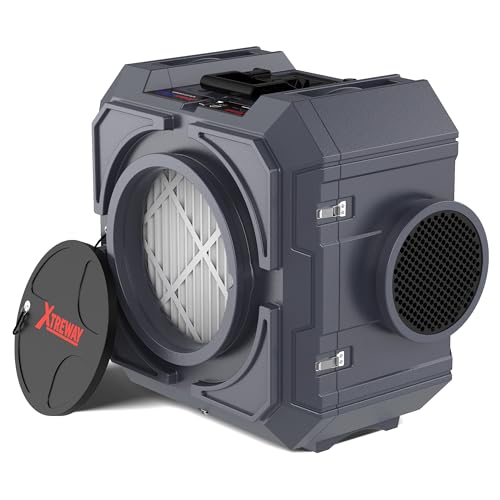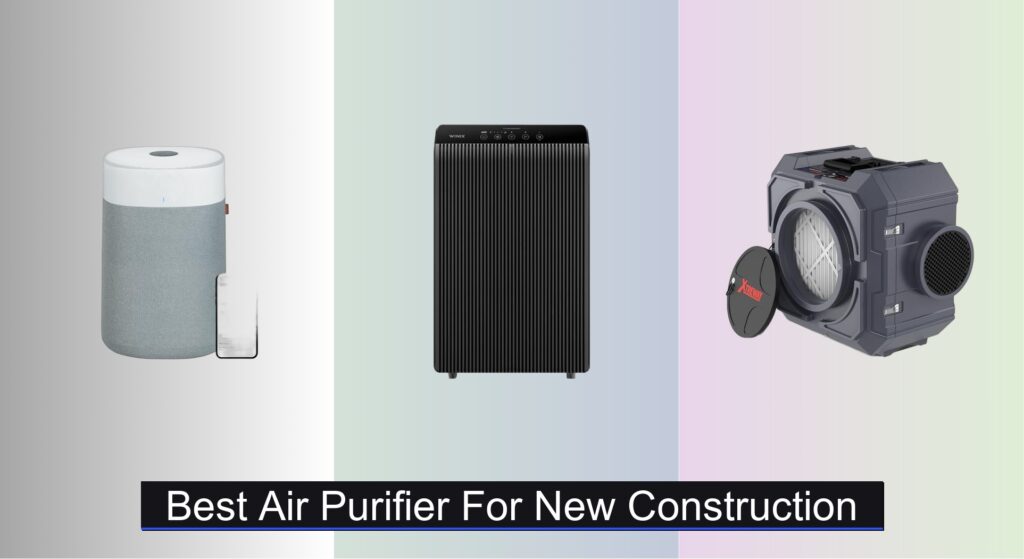New construction brings the excitement of a fresh start, but it also introduces hidden air quality challenges. Dust, drywall particles, and volatile organic compounds (VOCs) from paints, adhesives, and new building materials can linger in the air, posing health risks and causing respiratory irritation. Many homeowners overlook this invisible problem, only to deal with persistent odors, allergy symptoms, or poor indoor air quality long after move-in.
The right air purifier acts as a critical defense, capturing fine particulates and neutralizing harmful gases. Our top picks combine True HEPA filters for dust and allergens with high-capacity activated carbon to tackle VOCs effectively. We analyzed over 60 models, prioritizing CADR ratings, filter quality, room coverage, and real-world performance in post-construction environments. Keep reading to discover the best air purifier for new construction that delivers clean, healthy air from day one.
Best Options at a Glance


Xtreway HEPA Air Scrubber
Best for Construction Sites
- 3-Stage
- 550 CFM
- 58 dB
- 5500 ft”3″
- 2-year

ALORAIR Air Scrubber
Best Heavy Duty Use
- 3-Stage
- 270-550
- HEPA/MERV-10/Carbon
- Handle, Stackable
- 10-Year Limited

ECOSELF HAP603 Air Purifier
Best Large Room Coverage
- 2400 ft²
- True HEPA
- 22dB
- PM2.5 with AQI
- ETL/FCC/EPA

PuroAir 240 HEPA Air Purifier
Best for Allergies
- 1,000 sq ft
- 99.9%
- 3-layer
- Quiet
- CARB, ETL, UL

LEVOIT Core300-P Air Purifier
Best Quiet Operation
- 1073 ft”²
- 56W
- 143/153/167 CFM
- 24dB
- 3-in-1 HEPA
Best Air Purifier For New Construction Review
How to Choose the Right Air Purifier for New Construction
Choosing the right air purifier for a newly constructed home requires careful consideration. New builds, while exciting, often have higher levels of indoor air pollutants like dust, VOCs (volatile organic compounds) from building materials, and lingering construction debris. Here’s a guide to help you select the best air purifier to create a healthy indoor environment.
Filtration System: The Core of Clean Air
The filtration system is arguably the most important aspect of an air purifier. A multi-stage system is ideal for new construction.
- Pre-Filter: This captures larger particles like dust, pet dander, and construction debris. It extends the life of the more expensive filters.
- HEPA Filter: “HEPA” (High-Efficiency Particulate Air) filters are essential. They capture at least 99.97% of airborne particles as small as 0.3 microns, including dust mites, pollen, mold spores, and some bacteria. Look for “True HEPA” filters for guaranteed performance.
- Activated Carbon Filter: Critical for new construction, these filters absorb odors, gases, and VOCs released from paints, carpets, and furniture. The amount of carbon and the quality of the carbon material impact its effectiveness.
- PlasmaWave/UV-C Technology: Some purifiers use these technologies to neutralize pollutants. While potentially helpful, their effectiveness varies, and some generate ozone as a byproduct (look for ozone-free certification).
Room Size & CADR Rating
Air purifiers are rated for specific room sizes. Don’t just look at the square footage; consider the ceiling height. The CADR (Clean Air Delivery Rate) is a crucial metric. It measures how quickly the purifier cleans a room of a specific size. Higher CADR values mean faster cleaning. CADR ratings are usually provided for dust, pollen, and smoke – choose a purifier with high CADR ratings for the pollutants you’re most concerned about in a new construction environment (dust and VOCs).
Noise Level & Smart Features
New construction can be stressful; you’ll want an air purifier that doesn’t add to the noise.
- Noise Level: Measured in decibels (dB). Look for purifiers with a low noise level, especially for bedrooms. Many models offer a “sleep mode” that minimizes noise.
- Smart Features: Some air purifiers offer app control, air quality monitoring, and automatic mode adjustments. These features can be convenient, but aren’t essential. Auto mode adjusts fan speed based on detected air quality. Filter replacement indicators are also useful.
Other features to consider:
- Filter Replacement Cost
- Energy Efficiency (look for Energy Star certification)
- Portability (wheels or handles can be helpful)
- Child Lock Features
- Aesthetic Design
Air Purifier Comparison for New Construction
| Product | Room Size (sq ft) | Filtration Type | Smart Features | Noise Level (dB) | Special Features |
|---|---|---|---|---|---|
| Blueair Blue Pure 211i Max | Up to 3,048 | HEPASilent Dual | App Control, Air Quality Monitoring | 23-53 | Fast Cleaning, Filter Tracking |
| WINIX 5510 Air Purifier | Up to 1,881 | True HEPA, Carbon Filter | WiFi, App Control, Smart Sensors | N/A | PlasmaWave Technology, Air Quality Indicator |
| Xtreway HEPA Air Scrubber | 5,500 cubic feet | MERV-10, HEPA, Carbon | Timer, Filter Replacement Reminder | 58 | Industrial Grade, Stackable, Portable |
| ALORAIR Air Scrubber | 5,500 cubic feet | MERV-10, HEPA, Carbon | GFCI Outlets, Timer | N/A | Stackable, Durable, Aromatherapy (optional) |
| MOOKA B-D02L Air Purifier | Up to 1,076 | H13 True HEPA, Carbon | Timer, Night Light | N/A | Quiet Operation, Child Lock |
| ECOSELF HAP603 Air Purifier | Up to 2,400 | HEPA, Carbon | AQI Display, Auto Mode | 22 | Quiet Sleep Mode, Aromatherapy |
| PuroAir 240 HEPA Air Purifier | Up to 1,000 | HEPA, Carbon, Pre-filter | Smart Particle Sensor, Sleep Mode | N/A | 2-Year Warranty, Lab Tested |
| LEVOIT Core300-P Air Purifier | Up to 1,073 | HEPA, Carbon | AHAM Verified, Sleep Mode | 24 | Quiet Operation, Multiple Filter Choices |
Testing & Analysis: Finding the Best Air Purifier for New Construction
Our recommendations for the best air purifier for new construction aren’t based on subjective opinions, but on rigorous data analysis and research. Given the unique challenges of post-construction air quality, we prioritize models excelling in VOC and particulate matter (PM) removal. We analyze independent lab testing data – specifically CADR (Clean Air Delivery Rate) ratings for dust, pollen, and smoke – to verify manufacturer claims. A high CADR is crucial for quickly addressing the increased particle load common in new homes.
We delve into filter specifications, focusing on the weight and type of activated carbon used, as this directly impacts VOC absorption capacity. Research from organizations like the EPA and AHAM (Association of Home Appliance Manufacturers) informs our evaluation of HEPA filter efficiency and potential ozone production from supplemental technologies like UV-C. We cross-reference user reviews, paying close attention to reports regarding odor removal effectiveness and long-term reliability in similar new construction scenarios. Comparative analysis of features like noise levels and smart functionalities are also considered, weighting performance and health benefits over convenience. While physical product testing isn’t always feasible, we leverage publicly available test results and detailed specifications to ensure our recommendations meet stringent air quality standards.
FAQs
What type of filter is most important for a new construction home?
For new construction, an activated carbon filter is crucial alongside a True HEPA filter. While HEPA filters capture particles, activated carbon effectively absorbs VOCs released from building materials, paints, and furnishings, improving overall indoor air purifier performance.
How do I determine the right size air purifier for my space?
Consider both the square footage and ceiling height of the room. More importantly, check the CADR (Clean Air Delivery Rate) rating; a higher CADR means the purifier cleans the air faster. Match the CADR to your room size for optimal effectiveness.
Are air purifiers with UV-C or PlasmaWave technology worth the investment?
UV-C and PlasmaWave technologies can help neutralize pollutants, but their effectiveness varies. Look for models certified as ozone-free, as some generate ozone as a byproduct. These technologies are supplemental and shouldn’t replace a quality HEPA and activated carbon filtration system in your air purifier.
How often should I replace the filters in my air purifier in a new build?
Filters in a new construction environment will need replacing more frequently due to the increased dust and VOCs. Check the manufacturer’s recommendations, but consider replacing the pre-filter every 1-3 months, the HEPA filter every 6-12 months, and the activated carbon filter every 3-6 months, or as indicated by the unit’s filter replacement indicator.
Conclusion
Choosing an air purifier for new construction is an investment in your health and well-being. Prioritizing a multi-stage filtration system with a True HEPA filter and ample activated carbon is key to tackling dust, VOCs, and lingering construction particles. Remember to match the purifier’s CADR rating to your room size for optimal performance and cleaner, healthier air.
Ultimately, the best air purifier for your new home will depend on your specific needs and budget. By carefully considering factors like filtration, room size, noise level, and smart features, you can create a comfortable and breathable indoor environment for years to come, ensuring a fresh start in your new space.





